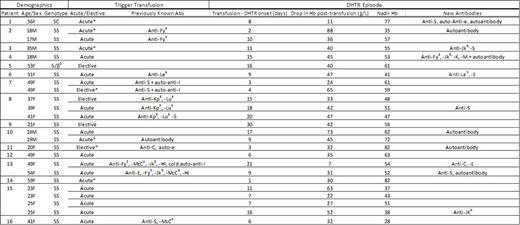Abstract
Background: Blood transfusion is a key intervention in the management of sickle cell disease (SCD), and is being increasingly used. Nonetheless, transfusion is not without risks; alloimmunisation to red blood cell antigens is a major complication, and can sometimes precipitate a delayed haemolytic transfusion reaction (DHTR), a potentially life-threatening event.
Objectives: We describe the prevalence, risk factors and experience of DHTR in a large cohort of adult patients with SCD.
Methods: Medical records of the 637 adult patients (all of African descent) regularly attending the SCD specialist clinic at King’s College Hospital, London, were retrospectively reviewed to identify DHTR cases. 362 (57%) were female, with 401 HbSS, 202 HbSC, 29 HbSβ+-thalassaemia (thal), 4 HbSβ0-thal, and 1 HbSSHPFH patients, mean age 36 ± 12 years. Between 1st August 2008 and 31st December 2013, 219 of the 637 patients received red blood cell transfusion, either as simple or exchange transfusion. 123 /219 (56%) of those who received transfusion were female, 84% HbSS genotype. Their Electronic Patient Records were examined, looking for a sharp drop in haemoglobin (Hb) after transfusion. If this was observed, laboratory data were combined with the clinical notes to detect evidence of a DHTR.
Results: We identified 25 DHTR episodes (1.2% of all transfusion episodes) in 16 patients (table 1). Six patients had repeat DHTR episodes – 4 twice, one thrice, and one 4 times. Mean age at transfusion was 35.5 ± 14.8 years. Indications for the transfusion that triggered the DHTR, included 20 acute pain episodes (some with acute chest syndrome), 3 pre-operative and 2 chronic exchange program. Mean interval from transfusion to DHTR onset was 11 ± 7 days. Typical presentations of DHTR were fever, pain and hemoglobinuria.
Blood results at DHTR diagnosis showed evidence of active haemolysis (mean LDH 1330 IU/L), and Hb drop (mean drop 40.4g/L, range 7 – 88g/L). 84% of episodes showed a severe haemolysis with nadir Hb lower than the pre-transfusion Hb. Mean reticulocyte count at peak haemolysis was 291 x109/L ± 121 x109/L. Eleven of the 25 episodes (44%) resulted in new red cell antibodies; 8 alloantibodies and 3 autoantibodies (table 1). DAT was positive in 16 of 19 (84%) cases where performed.
56% (14/25) of DHTR episodes were not diagnosed during admission, most often they were misdiagnosed as an acute pain crisis. Four of the 11 recognised DHTRs were treated with immunosuppression that included methylprednisolone, immunoglobulin, and, in one case, rituximab. All four of these uneventfully received further blood transfusions. The mean length of hospital stay was 15.9 days. 2/16 patients died, one of stroke, one of multi organ failure, giving a 13% mortality.
Discussion: Our data suggest that DHTRs are a severe but uncommon complication of blood transfusion. They are poorly recognised, possibly as their presentation mimics an acute painful crisis. Notably, most of the DHTRs are triggered by RBC transfusions in the acute setting. We recommend a high index of suspicion for DHTR in any SCD patient who has been transfused in the past month and presents acutely to clinicians, as early intervention can be life-saving.
*Exchange
No relevant conflicts of interest to declare.
Author notes
Asterisk with author names denotes non-ASH members.


This feature is available to Subscribers Only
Sign In or Create an Account Close Modal